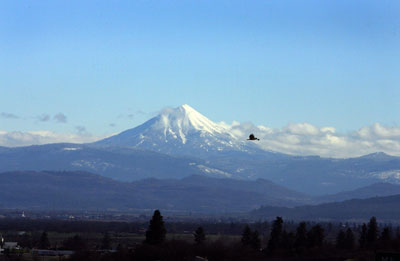|
Mount McLoughlin: Winter on the Rogue Valley's rooftop
 |
Zach Urness/Daily Courier
A bird glides in front of Mount McLoughlin, the highest peak in Southern Oregon. |
A winter climb on Mount McLoughlin, the highest peak in Southern Oregon, is both an exciting and dangerous trip. It requires snowshoes, crampons and an ice axe, and ascends a total of nearly 5,000 feet. Here’s a photo gallery of the Sky Lakes Wilderness, along with a video of climbing Mount McLoughlin. o o o oBy Zach Urness of the Daily CourierBefore Mount McLoughlin came into view above Interstate 5, rising high into the yellow-orange sky of early morning, my enthusiasm for a winter assault on Southern Oregon’s tallest peak was marginal.I’d been battling through a cold the previous two days and that morning, as I drove through the foggy darkness toward Medford, I was running on almost zero sleep. But there’s something about that first view of McLoughlin from the highway — the way it dominates the skyline like a white knife slicing above the horizon — that captures your attention no matter how many times you’ve seen it. Suddenly, the lingering cold and sleepless night were forgotten. The idea of climbing along the rooftop of the Rogue Valley provided more than enough adrenaline to put my foot on the gas and speed toward the southern Cascade volcano. As I would find out, a winter climb on McLoughlin is a large undertaking. The trip requires snowshoes, crampons and an ice axe. You can expect to bushwhack through the Sky Lakes Wilderness and ascend nearly 5,000 feet up the mountain’s south face toward an icy, dangerous and wind-polished summit. The winter route bears little resemblance to the popular summer hike, and is substantially more difficult. My trip began at milepost 31 on Highway 140 east of Medford, where I parked on the side of the road and snowshoed into an open gap in the forest. With my compass guiding due north, I hiked between old-growth pines sprouting up through the snow and filled my lungs with chilled morning air. After two or three miles, McLoughlin’s snowy cone began to emerge above the trees, providing the first view of a goal that seemed to stand directly above my head. The sky was a deep, rich blue and the mountain was so bright that each time I took off my sunglasses, it felt as though I was staring into a flashbulb. After swapping my snowshoes for crampons, I settled into a climbing rhythm using the “rest step,” which is the only realistic way to ascend thousands of feet up a wall of snow and ice. One-one-thousand. Step. Two-one-thousand. Step. Three-one-thousand. Step. And so on. The idea is to rest briefly between each step, without losing pace or wasting a single iota of energy by swaying side-to-side. For long periods of time the only entertainment is watching your shadow on the face of the mountain, and if it weren’t so physically difficult, it would probably be boring. The experience of winter mountaineering in high altitudes is best described as a powerful drug. Both physically and visually, everything feels magnified. The sun is brighter, the sky bluer and the raw panoramic beauty so immaculate, it’s difficult to concentrate. But climbing into the heavens also strips away that earthbound feeling of safety we take for granted. Because there’s no such thing as flat ground — it long ago dropped thousands of feet below your boots — you feel utterly helpless against the whims of the mountain. And it doesn’t take much to be scared witless. I reached the final ascent around noon and in the shimmering sunlight followed an ice-polished blade of snow that tightropes high above the sheer cliffs of the mountain’s northeast face. When I was about halfway up, a powerful, whipping wind began slamming the summit in violent bursts. As my jacket rippled like a windsock, the sickening fear of being swept clean off the north edge crept from my stomach to my head. The worst part was there was nothing to grab for assistance should I be knocked down, nothing to stop the wind from whipping me like a boomerang into the great wide open. And so I focused every fiber of my consciousness on slamming my crampons and ice axe into the crust of snow and pushing myself up, slowly, toward 9,495 feet. The wind relaxed slightly the higher I climbed, and I pulled myself onto a summit that was little more than a ribbon of soft snow. After I few pictures and shots with the video camera, I took a deep breath and climbed back down the high-altitude wind tunnel. Once I reached the lower altitudes, my brain finally kicked back into a normal operating mode, and I enjoyed the best part of climbing the mountain’s south face during winter. The south face is wide and steep enough for a long glissade, which could best be described as sledding without the sled. And so I dropped my backside onto the mountain that slices above the Rogue Valley horizon like a white knife, and slid downhill toward the old-growth pines of the Sky Lakes Wilderness. After a day when I was nearly tossed off Southern Oregon’s highest point, it felt pretty good to stick my butt on Mount McLoughlin. o o o oNotes: If you climb Mount McLoughlin during winter, it’s important to dress in layers, go with a buddy, begin climbing early in the morning, check for avalanche danger and bring enough gear to survive if you get trapped in a storm. ... Always check the weather before climbing and make sure to tell someone where you’re going and when you expect to return. Bonus McLoughlin: Click here for a gallery of pictures from Mount McLoughlin and the rest of the Sky Lakes Wilderness.
| 




